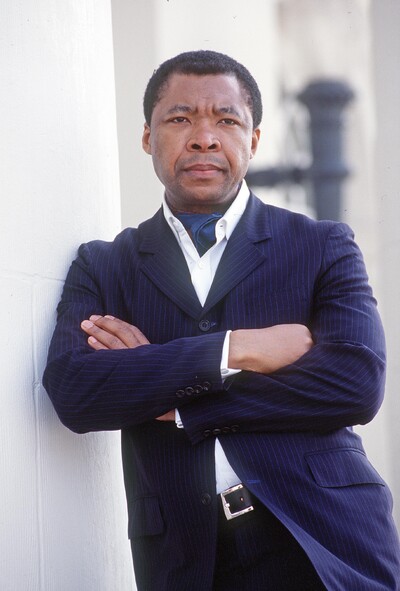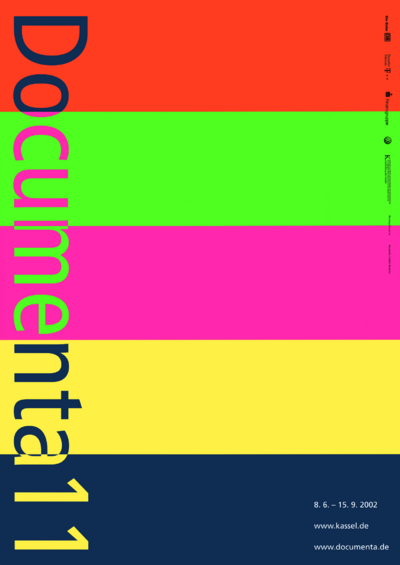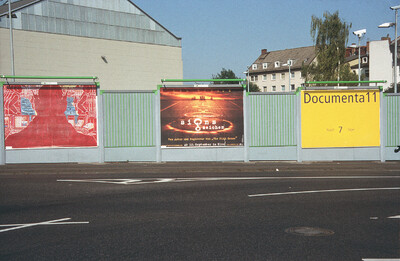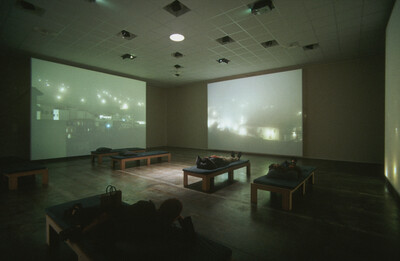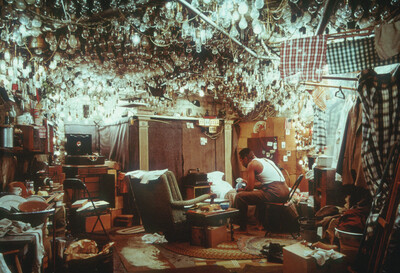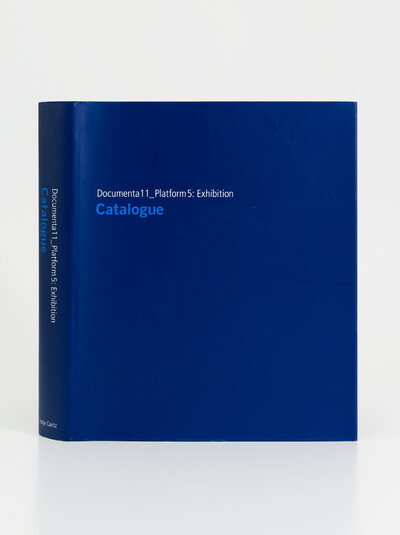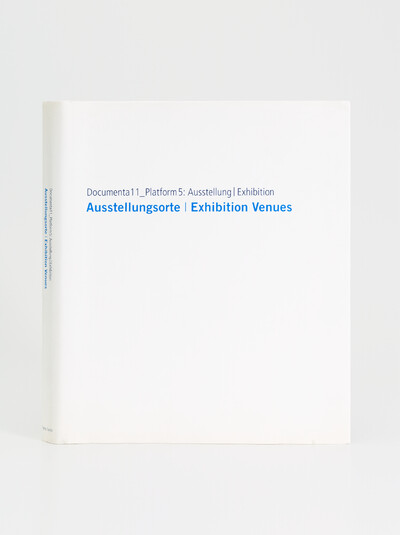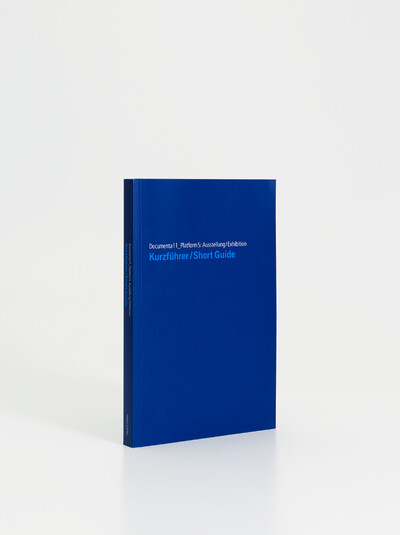Platform 5: Exhibition
- Artistic Direction
Okwui Enwezor
- Venues
Museum Fridericianum, documenta-Halle, Kulturbahnhof / Balikino, Binding-Brauerei, Orangerie, Karlsaue, Kassel city center / Nordstadt
- Artists
117
- Visitors
650.924
- Budget
18,075,420 Euro
- Website
- documenta11.de
Nigerian-born Okwui Enwezor was the first non-European to head documenta - the first documenta in the new millennium is regarded as the first truly global, post-colonial documenta. “documenta 11 is based on five platforms that attempt to describe the contemporary place of culture and its interfaces with other complex global knowledge systems.” The exhibition in Kassel was therefore only the fifth and final platform in the concept of Okwui Enwezor and his team of curators - consisting of Carlos Basualdo, Ute Meta Bauer, Susanne Ghez, Sarat Maharaj, Mark Nash and Octavio Zaya. One year before the official opening, transdisciplinary “platforms” on various themes took place on four continents: “Democracy as an unfinished process (Vienna, 15. 3.-20. 4. 2001; Berlin, 9.-30. 10. 2001), “Experimenting with Truth: Legal Systems in Transition and the Processes of Truth-Finding and Reconciliation” (New Delhi, 7-21. 5. 2001), “Créolité and Creolization” (St. Lucia, 13-15. 1. 2002) and “Under Siege: Four African Cities. Freetown, Johannesburg, Kinshasa, Lagos” (Lagos, March 16-20, 2002).
Many of the artistic works then shown in the exhibition took up these themes and other global problems in various ways. In keeping with the premise that “art is the production of knowledge”, many projects were documentary in character - however, the fear that the show would be too “theory-heavy” (a biased assessment that had already proven inaccurate at documenta 10) did not materialize. As Wolfgang Lenk writes in his catalog essay, the main achievement of documenta 11 was to question “the unspoken hierarchies of attention of the Western exhibition system”, to “deny the legitimacy of the West’s exoticizing view of ‘the foreign’ and to confront perception with those artistic activities that thwart our projection. […] The ‘strangers’ were the objects of our gaze - now they look back”. The change of gaze that Catherine David had prepared in 1997 was now finally accomplished.
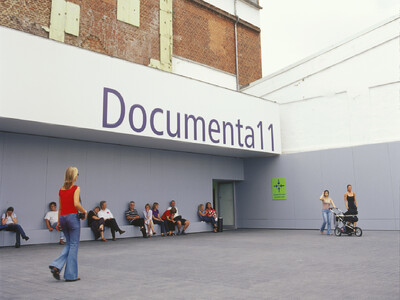
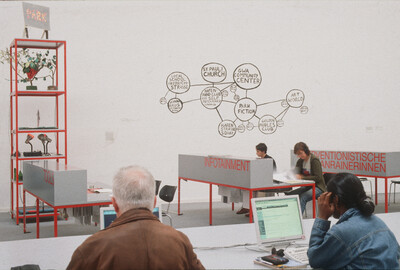
While the documenta hall primarily provided space for artist collectives and archive-based projects (Fareed Armalysand Rashid Masharawi’s visualization of Palestinian history From/To, 1999, the group Huit Facettes from Senegal, Le Groupe Amos from the Democratic Republic of Congo, the Raqs Media Collective from Delhi and Meschac Gaba with the library of his Museum of Contemporary African Art (2002)), the artworks in the Fridericianum and in the newly added exhibition venue Binding Brewery were generously staged - almost every artwork had its own space. Video projections (Steve McQueen, Yang Fudong) and expansive installations were predominant, such as Georges Adéagbo’s on-site object assemblage L’explorateur et les explorateurs devant l’histoire d’exploration …! Le théatre du monde (2002), Chohreh Feyzdjou’s Boutique Product of Chohreh Feyzdjou (1973-93) or the rooms by Mona Hatoum, Alfredo Jaar and Dieter Roth.
The juxtaposition of Doris Salcedo’s destroyed chairs covered in heavy lead with Leon Golub’s torture scenes painted on scraps of canvas was particularly oppressive. In the room next to it, Zarina Bhimji’s visually stunning video Out of the Blue (2002) was on display, showing abandoned military barracks, detention cells and prison rooms in a tropical landscape in slow tracking shots and, in contrast to the images of abandonment, a swelling soundscape of excited voices and gunshots - an audiovisual processing of her own memory. As a nine-year-old, Bhimji was forcibly expelled from Uganda with her family and thousands of other Asian immigrants.
These three works, prominently displayed on the first floor of the Fridericianum, impressively recalled experiences of state violence, which was to continue with Tania Bruguera’s performance installation Untitled (2002) in the Binding Brewery. Here, visitors were alternately exposed to total darkness or glaring light and, deprived of their ability to see, only heard sounds such as the military stamping of boots or the assembling of a rifle. In front of the Fridericianum, Cildo Meireles had mobile ice cream vendors hand out water ice sticks, but they had no taste - they simply consisted of frozen water. The title of the work, Disappearing Element / Disappeared Element (Imminent Past) (2002), was a reminder of the increasing reality of water scarcity in many parts of the world.
The works installed in the Auepark also referred to complex contexts far beyond their sculptural appearance - for example Dominique Gonzalez-Foerster’s “Sculpture Park” made up of elements such as a telephone box from Brazil, a rose bush from Le Corbusier’s rose garden in Chandigarh, India, and a lava stone from Mexico.Brazil, a rose bush from Le Corbusier’s rose garden in Chandigarh, India, and a lava stone from Mexico, which formed an associative reference system of cultural symbols, or Renée Green’s open-air pavilion Standardized Octogonal Units for Imagined and Existing Systems (2002) consisting of eight units with audiovisual material on seemingly disparate themes such as the alphabet, Africa, color, island, food, work, woman, man, gender and others.
And deep in Kassel’s Nordstadt district, which is considered a social hotspot, Thomas Hirschhorn erected his Bataille Monument (2002) in the middle of a social housing estate. The archive about the thinker of free spending and critic of utility, built in collaboration with local young people from cheap building materials, was open to the residents - an experiment between success and failure that, with its various problems, revealed the still difficult dialog between contemporary art and the so-called “social underclass”.

Gallery
Artists
a
- Adéagbo, Georges
- Agarwal, Ravi
- Ahtila, Eija-Liisa
- Akerman, Chantal
- Ancelovici, Gaston A.
- Armaly, Fareed
- Ashkin, Michael
- Asymptote Architecture
- Ataman, Kutlug
b
- Bargmann, Julie & Stacy Levy
- Barrio, Artur
- Becher, Bernd & Hilla
- Bhimji, Zarina
- Black Audio Film Collective
- Bock, John
- Bonk, Ecke
- Bouabré, Frédéric Bruly
- Bourgeois, Louise
- Braila, Pavel
- Brouwn, Stanley
- Bruguera, Tania
c
- Camnitzer, Luis
- Coleman, James
d
- Darboven, Hanne
- Deacon, Destiny
- Douglas, Stan
e
- Edefalk, Cecilia
- Eggleston, William
- Eichhorn, Maria
- Ennadre, Touhami
- Evans, Cerith Wyn
f
- Feng Mengbo
- Feyzdjou, Chohreh
- Friedman, Yona
g
- Gaba, Meschac
- Gabellone, Giuseppe
- Garaicoa, Carlos
- Geers, Kendell
- Genzken, Isa
- Geys, Jef
- Goldblatt, David
- Golub, Leon
- Gonzalez-Foerster, Dominique
- Green, Renée
- Grippo, Victor
h
- Haaning, Jens
- Hatoum, Mona
- Hirschhorn, Thomas
- Horsfield, Craigie
- Huit Facettes
- Huyghe, Pierre
- Höfer, Candida
i
- Igloolik Isuma Productions
- Ivekovic, Sanja
j
- Jaar, Alfredo
- Jonas, Joan
- Julien, Isaac
k
- Kanwar, Amar
- Kawara, On
- Kentridge, William
- Keuken, Johan van der
- Kingelez, Bodys Isek
- Kinmont, Ben
- Kopystiansky, Igor & Svetlana
- Kožarić, Ivan
- Kulunčić, Andreja
l
- Le Groupe Amos
- Ligon, Glenn
- Lum, Ken
m
- Manders, Mark
- Marcaccio, Fabian
- McQueen, Steve
- Meireles, Cildo
- Mekas, Jonas
- Messager, Annette
- Miyamoto, Ryuji
- Mofokeng, Santu
- Multiplicity
- Muñoz, Juan
n
- Neshat, Shirin
- Nieuwenhuys, Constant A.
o
- Orozco, Gabriel
- Osifuye, Olumuyiwa Olamide
- Ottinger, Ulrike
- Ouattara Watts
p
- Park Fiction
- Pernice, Manfred
- Pettibon, Raymond
- Piper, Adrian
- Ponger, Lisl
- Portabella, Pere
r
- Raqs Media Collective
- Riera, Alejandra with Doina Petrescu
- Roth, Dieter
s
- Salcedo, Doris
- Samadian, Seifollah
- Saussier, Gilles
- Sekula, Allan
- Shonibare, Yinka
- Siekmann, Andreas
- Simparch
- Simpson, Lorna
- Sivan, Eyal
- Small, David
t
- Tan, Fiona
- Tayou, Pascale Marthine
- Teno, Jean-Marie
- The Atlas Group
- Trinh T. Minh-ha
- Tsunamii.net
- Tuerlinckx, Joëlle
- Tuymans, Luc
u
- Urbonas, Nomeda & Gediminas
w
- Wall, Jeff
- Ward, Nari
- Watts, George Frederick
y
- Yang, Fudong
Artistic Director
Okwui Enwezor
born 1963 in Calabar, Nigeria, died 2019 in Munich
1982-1987
Studied political science at New Jersey City State College, New Jersey, USA1987-1993 Published as a poetry writer
1993 Founded the magazine NKA: Journal of Contemporary African Art together with Chika Okeke-Agulu and Salah Hassan
1996-1997 Foundation of the magazine NKA: Journal of Contemporary African Art together with Chika Okeke-Agulu and Salah Hassan
1998-2002 Artistic Director of documenta 11, Kassel
2006 Artistic Director of the Biennial in Seville, Seville
2007-2008 Artistic Director of the Gwangju Biennale, Gwangju, South Korea
Since 2011 Director of the Haus der Kunst, Munich
2012 Curator of La Triennale, Paris
2014-2015 Artistic Director of the 56th Venice Biennale, Venice
Exhibitions (selection)
1996 In/Sight: African Photographers, 1940 to the present, Guggenheim Museum, New York
1999 Global Conceptualism, Queens Museum, New York; Walker Art Center, Minneapolis
2000 Mirror's Edge, Bildmuseet Umeå, Umeå, Sweden
2001 Century City, Tate Modern, London
2002 documenta 11, Kassel
2008 Archive Fever: Uses of the Document in Contemporary Art, International Center of Photography, New York
2009 Snap Judgments: New Positions in African Photography, International Center fo Photography, New York
2013 The Rise and Fall of Apartheid: Photography and the Bureaucracy of Everyday Life, Haus der Kunst, Munich
2013 Ai Weiwei: So Sorry, Haus der Kunst, Munich
Awards (selection)
2014 Timerhi Award for Leadership in the Arts
2014 Federal Cross of Merit of the Federal Republic of Germany
2015 Hessian Culture Prize for his work as Artistic Director of documenta 11
